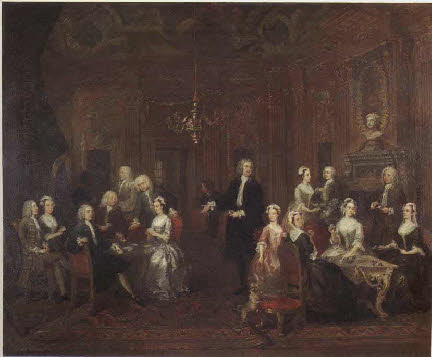“Painter of portrait, history and ‘modern moral subjects’; and equally as important
as an engraver. Born and died in London. He was the painter of some of the great
masterpieces of British painting, and was the most energetic, controversial, and
ultimately influential figure in the London arts scene of the 1740s, but his uncompromising
and basically anti-academic temperament reduced his immediate influence and thwarted
his major ambition to become the great history painter of his age, in succession
to his father-in-law, Thornhill. He was trained first as an ornamental engraver and
began his independent career with satirical prints. He was a beautiful draughtsman
and learned painting at the Vanderbank Academy and by memorizing everything he could
set eyes on; his enchanting virtuosity in the use of oil paint suggests French experience.
Serious paintings begin 1728/9 with versions of ‘The Beggar’s Opera’ and
from then until the middle 1730s he specialized in small-scale conversation pieces
and single portraits on the same scale. His most accomplished picture on this scale
is ‘Children Playing “The Indian Emperor”,’ 1731/2 (Lady Theresa Agnew). He then
embarked on his first series of modern moral subjects, now known only by the 1732
engravings – ‘The Harlot’s Progress’. These were not quite as wholly novel in subject
matter as Hogarth pretended (Jan Steen was a notable precursor), but their popularization
by engravings made them appeal to the common public and especially to the middle
classes, to whom Hogarth’s art was increasingly addressed. He secured the passing
of a copyright act before his next series, ‘The Rake’s Progress’, engraved 1735 (Soane
Museum). On Thornhill’s death (1734) he inherited the equipment of the first Academy
and established the St. Martin’s Lane Academy which was extremely influential and
run on anti-academic lines. In 1735/6 he painted two large histories for St. Bartholomew’s
Hospital – but these did not provoke commissions for history painting and, for a
time, Hogarth turned to portrait painting on the scale of life. His ‘Captain Coram’,
1740, presented to the new founded Foundling Hospital, is one of the great landmarks
in the history of the British portrait – a portrait of a middle class philanthropist,
with all the weight and none of the pretentiousness of a state portrait. His finest
portraits, mostly busts, date from the 1740s. In 1743 he visited Paris, where he
could have seen the work of Chardin, the other great middle class painter of the
century. From 1743 to 1745 he was painting the ‘Marriage à la Mode’ series (NG),
which is his most sustained achievement, and he was also instrumental in getting
his friend Jonathan Tyers to commission Hayman and others to paint the Vauxall decorations.
These, and the history, portrait and topographical pictures which (urged on by Hogarth)
a group of artists presented to the Foundling Hospital provided the first opportunities
for the works of contemporary painters to be seen by the public outside the artists’
own studios.
By the later 1740s Hogarth had achieved the best of his work in painting.
He turned to engraving of a more popular kind and to the writing (1748-53) of a theoretical
work The Analysis of Beauty, which had rather a bad press – partly due to his own
pugnacity and hostility to the upper class art pundits of the age. His last modern
moral series ‘The Election’, was began in 1754 (Soane Museum). His output of engravings
was prodigious and extremely influential. His powers as a painter remained unimpaired
to the end, as his ‘Sigismunda’, 1759 (Tate Gallery), a programmatic attack on the
craze for old masters, and the profoundly sensitive picture known as ‘Hogarth’s servants’,
painted for himself and without thought of public praise or blame (Tate Gallery),
make clear. This last picture has never been surpassed as a revelation of the possibilities
of the art of a portrait painter.”
(Bibliographical source: Waterhouse, Ellis Kirkham. The dictionary of British 18th
century painters in oils and crayons. Woodbridge: Antique Collectors' Club, 1981.)

